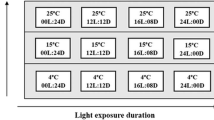Summary
Intracellular bacteria belonging to two phylogenetically different groups of eubacteria were found in cultures of the freshwater dinoflagellatePeridinium cinctum (O. F. Müller) Ehrenberg isolated from the eutrophic lake Plußsee (Federal Republic of Germany). The phylogenetic relationships of the bacteria were studied with fluorochrome-conjugated oligonucleotides specific for archaebacteria, eubacteria, α-, β- and γ-proteobacteria, complementary to 16S rRNA and 23S rRNA sequences, respectively. The bacteria are members of the eubacterial α- and γ-subgroups of proteobacteria.
Similar content being viewed by others
References
Amann RI, Krumholz L, Stahl DA (1990) Fluorescentoligonucleotide probing of whole cells for determinative, phylogenetic, and environmental studies in microbiology. J Bacteriol 172: 762–770
—, Springer N, Ludwig W, Görtz H-D, Schleifer KH (1991) Identification in situ and phylogeny of uncultured bacterial endosymbionts. Nature 351: 161–164
Brugerolle G, Mignot JP (1979) Observations sur le cycle l'ultrastructure et la position systématique deSpiromonas perforans (Bodo perforans Hollande 1938), flagellé parasite deChilomonas paramaecium: ses relations avec les dinoflagellés et sporozoaires. Protistologica 15: 183–196
Calado AJ, Hansen G, Moestrup Ø (1999) Architecture of the flagellar apparatus and related structures in the type species ofPeridinium, P. cinctum (Dinophyceae). Eur J Phycol 34: 197–191
Carefoot JR (1968) Culture and heterotrophy of the freshwater dinoflagellatePeridinium cinctum f.ovoplanum (Lindemann). J Phycol 4: 174–192
Chesnick JM, Cox ER (1986) Specialization of endoplasmatic reticulum architecture in response to a bacterial symbiosis inPeridinium balticum (Pyrrhophyta). J Phycol 22: 291–298
Dürr G (1979) Electron microscopical studies on the theca of dinoflagellates II:Peridinium cinctum. Arch Protistenkd 122: 88–120
Fenchel T, Bernard C, Esteban G, Finlay BJ, Hansen PJ (1995) Microbial diversity and activity in a Danish fjord with anoxic deep water. Ophelia 43: 45–100
Finlay BJ, Berninger U-G, Clarke KJ, Cowling AJ, Hindle RM, Rogerson A (1988) On the abundance and distribution of protozoa and their food in a productive freshwater pond. Eur J Protistol 23: 205–217
Fokin S, Karpov S (1995) Bacterial endosymbionts inhabiting the perinuclear space of protista. Endocytobios Cell Res 11: 81–94
—, Brigge T, Brenner J, Görtz H-D (1996)Holospora species infecting the nuclei ofParamecium appear to belong into two groups of bacteria. Eur J Protistol 32 Suppl: 19–24
—, Sabaneyeva EV, Borkhsenious ON, Schweikert M, Görtz H-D (2000)Paramecium calkinsi andP. putrinum (Ciliophora, Protista) harbouring alpha-subgroup bacteria in the cytoplasm. Protoplasma 213: 176–183
Gallagher S, Smith EA (1999) Bacteria and paralytic shellfish toxins. Protist 150: 245–255
Görtz H-D (1983) Endonuclear symbionts in ciliates. Int Rev Cytol Suppl 16: 145–176
— (1987) Different endocytobionts simultaneously colonizing ciliate cells. Ann NY Acad Sci 503: 561–568
—, Brigge T (1998) Intracellular bacteria in protozoa. Naturwissenschaften 85: 359–368
Guillard RRL, Lorenzen CJ (1972) Yellow-green algae with chlorophyllide c. J Phycol 8: 10–14
Huber-Pestalozzi G (1968) Das Phytoplankton des Süßwassers: Systematik und Biologie. E Schweizerbart'sche Verlagsbuchhandlung, Stuttgart, pp 94–322 (Thienemann A, Elster H-J, Ohle W [eds] Die Binnengewässer, vol 16)
Lafay B, Rumy R, Rausch de Traubenberg C, Breittmayer V, Gauthier MJ, Christen R (1995)Roseobacter agricola sp. nov., a new bacterium isolated from the phycosphere of the toxinproducing dinoflagellateProrocentrum lima. Int J Bacteriol 45: 290–296
Lucas IAN (1982) Observations onNoctiluca scintillons Macartney (Ehrenb.) (Dinophyceae) with notes on an intracellular bacterium. J Plankton Res 4: 401–409
Manz W, Amann R, Ludwig W, Wagner M, Schleifer K-H (1992) Phylogenetic oligonucleotide probes for the major subclasses of proteobacteria: problems and solutions. Syst Appl Microbiol 15: 593–600
Neef A (1997) Anwendung der in-situ-Einzell-Identifizierung von Bakterien zur Populationsanalyse von Komplexen mikrobiellen Biozönosen. PhD thesis, Technical University Munich, Munich, Federal Republic of Germany
Pfiester LA (1975) Sexual reproduction ofPeridinium cinctum f.ovoplanum (Dinophyceae). J Phycol 11: 259–265
Preer JR, Preer LB, Jurand A (1974) Kappa and other endosymbionts inParamecium aurelia. Bacteriol Rev 38: 113–163
Prokic I, Brümmer F, Brigge T, Görtz H-D, Gerdts G, Schütt C, Elbrächter M, Müller WEG (1998) Bacteria of the genusRoseobacter associated with the toxic dinoflagellateProrocentrum lima. Protist 149: 347–357
Schnepf E (1992) From prey via endosymbiont to plastid: comparative studies in dinoflagellates. In: Lewin RE (ed) Origins of plastids. Chapman and Hall, New York, pp 53–76
—, Elbrächter M (1992) Nutritional strategies in dinoflagellates: a review with emphasis on cell biological aspects. Eur J Protistol 28: 3–24
— — (2000) Dinophyte chloroplasts and phytogeny: a review. Grana 38: 81–97
—, Melkonian M (1990) Bacteriophage-like particles in endocytic bacteria ofCryptomonas (Cryptophyceae). Phycologia 29: 338–343
—, Hegewald E, Soeder C-J (1974) Elektronenmikroskopische Beobachtungen an Parasiten ausScenedesmus-Massenkulturen 4: Bakterien. Arch Mikrobiol 98: 133–145
Silva ESE (1978) Endonuclear bacteria in two species of dinoflagellates. Protistologica 14: 113–119
— (1990) Intracellular bacteria: the origin of dinoflagellate toxicity. J Environ Pathol Toxicol Oncol 10: 124–128
Sousa-Silva E, Franca S (1986) The association dinoflagellatebacteria: their ultrastructural relationship in two species of dinoflagellates. Protistologica 21: 429–446
Spector DL, Triemer RE (1979) Ultrastructure of the dinoflagellatePeridinium cinctum f.ovoplanum I: vegetative cell ultrastructure. Am J Bot 66: 845–850
—, Pfiester LA, Triemer RE (1981) Ultrastructure of the dinoflagellatePeridinium cinctum f.ovoplanum II: light and electron microscopic observations on fertilization. Am J Bot 68: 34–43
—, Triemer RE, Vasconcelos AC (1979) Visualization of chromosome duplication in the protozoanPeridinium cinctum (Dinophyceae). J Cell Biol 83: 160a
Spurr AR (1969) A low viscosity epoxy resin embedding medium for electron microscopy. J Ultrastruct Res 26: 31–43
Stahl DA, Amann RI (1991) Development and application of nucleic acid probes in bacterial systematics. In: Stackebrandt E, Goodfellow M (eds) Nucleic acid techniques in bacterial systematics. Wiley, Chichester, pp 205–248
Surek B, Melkonian M (1983) Intracellular bacteria in the Euglenophyceae: prolonged axenic culture of an algal-bacterial system. In: Schenk HEA, Schwemmler W (eds) Endocytobiology II. Walter de Gruyter, Berlin, pp 475–486
Wagner S, Schulz S, Hanselmann K (1990) Abundance and distribution of anaerobic protozoa and their contribution to methane production in Lake Cadagno (Switzerland). FEMS Microbiol Ecol 74: 39–48
Author information
Authors and Affiliations
Rights and permissions
About this article
Cite this article
Schweikert, M., Meyer, B. Characterization of intracellular bacteria in the freshwater dinoflagellatePeridinium cinctum . Protoplasma 217, 177–184 (2001). https://doi.org/10.1007/BF01283398
Received:
Accepted:
Issue Date:
DOI: https://doi.org/10.1007/BF01283398




